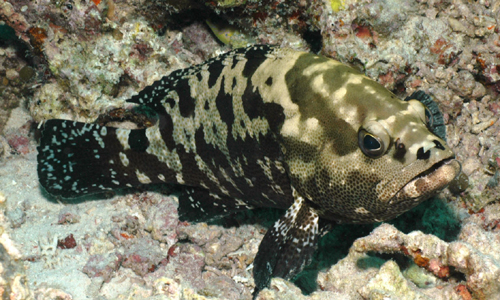The development of marine culture can be one of the new jobs for fishers, which can be used to increase food production (sea fish protein) for the community. One type of sea fish that has economic value is grouper (Epinephelus sp). Grouper fish is a sea fish that lives on coral reefs; the fish has high economic value and has the potential to be developed in Indonesia. Cases of fungal diseases in fish in Indonesia have generally not been taken seriously and mostly caused by unfavourable environmental conditions, nutritional deficiencies or due to other primary infectious agents such as parasites, bacteria, and viruses.
Diseases caused by fungi are secondary infections because fungi rarely infect healthy fish, but infect fish that have been injured or are weak. The fungus is quickly transmitted to other fish in one pond so that the potential losses are large enough. Karamba is floating net on the North Coast of Surabaya with a location close to the industrial environment. So there is a possibility of being influenced by the quality of the water around the floating net cages.
This research was conducted using a survey method through data collection at the site directly. A sampling of grouper (Epinephelus sp) with a size of 25-30 cm totalling ten heads was used in this study. Furthermore, fungi were isolated from grouper samples that had been obtained. Isolates in the form of scrapings (scrapping) the surface of the fish’s body and then planted on SDA media and incubated at 25ºC for 3-4 days.
Purified fungi are ready to be identified. The identification technique used to observe fungi isolates is the masking tape method. It starts by preparing a glass object and then dropping it with a drop of lactophenol blue solution. Then the tape is taken to taste and then placed on the fungus that grows on the media. The tape is affixed to the glass object that has been dripped with lactophenol blue and then closed using a glass cover observed under a microscope with a magnification of 100 and 400X, and the visible fungi can be identified.
Identification of fungi using conventional identification techniques which includes two stages, namely macroscopic and microscopic fungi observation. Macroscopic observations included colonies and colony colours, while microscopic observations included hyphal and spore forms. The location of the spores is carried out according to the identification procedure.
The results of the study can be isolated and identified into 3 (three) fungi in groupers (Epinephelus sp) in floating net cages, namely, Aspergillus flavus, Aspergillus niger, and Penicillium glabrum. Fungi infected fish show clinical symptoms, visible objects that resemble cotton on the fins, the surface of the skin or gills. Fungi will damage the fish body’s outer tissue that is preceded by injuries due to parasites or other causes. The emergence of fungi is caused by stress due to poor water quality, high stocking densities, and inadequate cultivation techniques that cause drastic changes. These changes disrupt the environmental balance and reduce endurance of fish. This fungus will cause losses and damage the appearance of the grouper and will harm the farmers. Besides, the presence of fungi in large numbers causes infected fish to die and cause losses to farmers.
Aspergillus flavus is a fungus that produces aflatoxin. Aflatoxin is a toxin found in the fish feed that is overgrown by fungi. One type of aflatoxin that causes serious problems in aquaculture is aflatoxin B1 (AFBı). Aflatoxin can cause fish growth to be disrupted. Clinical symptoms of infected fish include pale gills, circulatory system, decreased immune system, anemia, impaired growth, lack of body weight and long-term effects causing disorders of the liver which results in high mortality of fish. Aspergillus niger is a fungus whose habitat is in the gills and fish scales. The uncontrolled environment is a trigger for the growth of Aspergillus niger. Penicillium sp. is a type of fungus that is better known as an antibiotic-producing fungus.
Based on the results of the study, it can be concluded that there are two species of fungi that have the potential to cause infectious diseases in Grouper (Epinephelus sp.) Which are cultivated on the North Coast of Surabaya, namely Aspergillus flavus and Aspergillus niger.
Author: Rahayu Kusdarwati
The research results can be seen on
https://iopscience.iop.org/article/10.1088/1755-1315/236/1/012007/pdf
E. Yuliastuti, Rahayu Kusdarwati, Sudarno. 2019. The prevalence of fungi on groupers (Epinephelus sp) in cage mariculture systems of the northern coast of Surabaya, East Java. IOP Conference Series Earth and Environmental Science 236(1):012007





